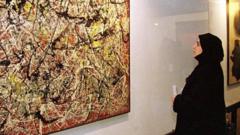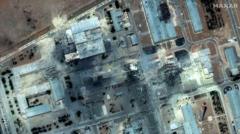Decades of art history lie hidden in Tehran's vaults, home to invaluable works and a fascinating cultural legacy waiting to be rediscovered.
Rare Art Masterpieces in Tehran Vault: A Hidden Cultural Treasure

Rare Art Masterpieces in Tehran Vault: A Hidden Cultural Treasure
Explore the secretive world of Tehran's art vault, housing masterpieces from Picasso to Pollock.
The Tehran Museum of Contemporary Art has long been a treasure trove of modern masterpieces, with a collection that includes works by iconic artists such as Pablo Picasso, Vincent Van Gogh, Andy Warhol, and Jackson Pollock. Estimated to be worth around $3 billion, many of these works have remained mostly unexhibited since the 1979 Iranian Revolution, which saw the country's art narrative dramatically shift.
Recent years have seen a resurgence in showcasing these hidden treasures, most notably highlighted by the Eye to Eye exhibition, which launched in October 2024 and was extended due to public interest, running until January 2025. This exhibition was deemed one of the museum's most significant and included over 15 artworks previously unseen by the public, including Jean Dubuffet's sculpture, marking its Iranian debut.
The collection serves as a compelling testament to key art movements, featuring Warhol's rare portrait of Farah Pahlavi, the last queen of Iran, and a Francis Bacon painting, "Two Figures Lying on a Bed with Attendants," which presents a striking commentary when juxtaposed against a portrait of Ayatollah Ruhollah Khomeini, foundational figure of the Islamic Republic.
Initiated under the regime of the last Shah in 1977, the Tehran Museum of Contemporary Art was designed to serve as a bridge between Iranian culture and global artistic movements. However, following the revolution, many artworks were deemed too scandalous or politically sensitive, resulting in their confinement to the museum’s basement, which has become the stuff of legend.
It wasn't until the late 1990s during a reformist movement that the museum began to reclaim its stature, with select pieces loaned for exhibitions in Europe and the United States, re-establishing its connection with the global art community. Art historian Hamid Keshmirshekan globalizes this unique collection as "one of the rarest treasure troves of modern art outside the West."
The collection includes significant works such as Pollock's "Mural on Indian Red Ground," Picasso's "The Painter and His Model," and Van Gogh's "At Eternity's Gate." Despite its immense cultural value, the Tehran Museum still faces challenges related to budget constraints and shifting political priorities, ultimately remaining a crucial custodian of modern art in Tehran, acting more as a cultural hub rather than a conventional museum.
Yet for many art enthusiasts, particularly in the UK, access to these masterpieces remains a distant dream, as travel warnings and significant political tensions make visiting Iran problematic. Thus, Tehran stands as an unlikely yet vital guardian of modern art, nestled amid the complexities of a storied and turbulent cultural landscape.
Recent years have seen a resurgence in showcasing these hidden treasures, most notably highlighted by the Eye to Eye exhibition, which launched in October 2024 and was extended due to public interest, running until January 2025. This exhibition was deemed one of the museum's most significant and included over 15 artworks previously unseen by the public, including Jean Dubuffet's sculpture, marking its Iranian debut.
The collection serves as a compelling testament to key art movements, featuring Warhol's rare portrait of Farah Pahlavi, the last queen of Iran, and a Francis Bacon painting, "Two Figures Lying on a Bed with Attendants," which presents a striking commentary when juxtaposed against a portrait of Ayatollah Ruhollah Khomeini, foundational figure of the Islamic Republic.
Initiated under the regime of the last Shah in 1977, the Tehran Museum of Contemporary Art was designed to serve as a bridge between Iranian culture and global artistic movements. However, following the revolution, many artworks were deemed too scandalous or politically sensitive, resulting in their confinement to the museum’s basement, which has become the stuff of legend.
It wasn't until the late 1990s during a reformist movement that the museum began to reclaim its stature, with select pieces loaned for exhibitions in Europe and the United States, re-establishing its connection with the global art community. Art historian Hamid Keshmirshekan globalizes this unique collection as "one of the rarest treasure troves of modern art outside the West."
The collection includes significant works such as Pollock's "Mural on Indian Red Ground," Picasso's "The Painter and His Model," and Van Gogh's "At Eternity's Gate." Despite its immense cultural value, the Tehran Museum still faces challenges related to budget constraints and shifting political priorities, ultimately remaining a crucial custodian of modern art in Tehran, acting more as a cultural hub rather than a conventional museum.
Yet for many art enthusiasts, particularly in the UK, access to these masterpieces remains a distant dream, as travel warnings and significant political tensions make visiting Iran problematic. Thus, Tehran stands as an unlikely yet vital guardian of modern art, nestled amid the complexities of a storied and turbulent cultural landscape.






















